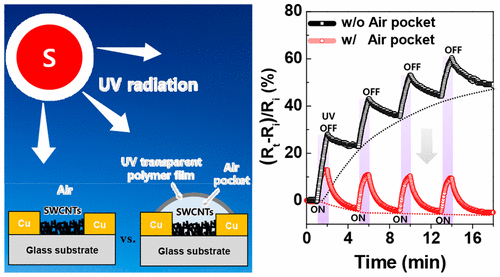Our official English website, www.x-mol.net, welcomes your
feedback! (Note: you will need to create a separate account there.)
Single Walled Carbon Nanotube Based Air Pocket Encapsulated Ultraviolet Sensor
ACS Sensors ( IF 8.2 ) Pub Date : 2017-10-26 00:00:00 , DOI: 10.1021/acssensors.7b00585 Sun Jin Kim 1 , Jin-Woo Han 1 , Beomseok Kim 1 , M. Meyyappan 1
ACS Sensors ( IF 8.2 ) Pub Date : 2017-10-26 00:00:00 , DOI: 10.1021/acssensors.7b00585 Sun Jin Kim 1 , Jin-Woo Han 1 , Beomseok Kim 1 , M. Meyyappan 1
Affiliation

|
Carbon nanotube (CNT) is a promising candidate as a sensor material for the sensitive detection of gases/vapors, biomarkers, and even some radiation, as all these external variables affect the resistance and other properties of nanotubes, which forms the basis for sensing. Ultraviolet (UV) radiation does not impact the nanotube properties given the substantial mismatch of bandgaps and therefore, CNTs have never been considered for UV sensing, unlike the popular ZnO and other oxide nanwires. It is well-known that UV assists the adsorption/desorption characteristics of oxygen on carbon nanotubes, which changes the nanotube resistance. Here, we demonstrate a novel sensor structure encapsulated with an air pocket, where the confined air is responsible for the UV sensing mechanism and assures sensor stability and repeatability over time. In addition to the protection from any contamination, the air pocket encapsulated sensor offers negligible baseline drift and fast recovery compared to previously reported sensors. The air pocket isolated from the outside environment can act as a stationary oxygen reservoir, resulting in consistent sensor characteristics. Furthermore, this sensor can be used even in liquid environments.
中文翻译:

基于单壁碳纳米管的气袋封装紫外线传感器
碳纳米管(CNT)是一种有前途的候选材料,可用于敏感地检测气体/蒸汽,生物标志物,甚至某些辐射,因为所有这些外部变量都会影响纳米管的电阻和其他特性,从而构成了传感的基础。考虑到带隙的严重失配,紫外线(UV)不会影响纳米管的性能,因此,与流行的ZnO和其他氧化物纳米线不同,从未考虑过将CNT用于紫外线感测。众所周知,紫外线有助于氧气在碳纳米管上的吸附/解吸特性,这会改变纳米管的电阻。在这里,我们展示了一种新型的带有气袋的传感器结构,其中受限的空气负责紫外线感应机制,并确保传感器随时间推移的稳定性和可重复性。除了防止受到任何污染外,与以前报道的传感器相比,气密传感器还提供了可忽略的基线漂移和快速恢复。与外部环境隔离的气袋可以充当固定的氧气储存器,从而实现一致的传感器特性。此外,该传感器甚至可以在液体环境中使用。
更新日期:2017-10-27
中文翻译:

基于单壁碳纳米管的气袋封装紫外线传感器
碳纳米管(CNT)是一种有前途的候选材料,可用于敏感地检测气体/蒸汽,生物标志物,甚至某些辐射,因为所有这些外部变量都会影响纳米管的电阻和其他特性,从而构成了传感的基础。考虑到带隙的严重失配,紫外线(UV)不会影响纳米管的性能,因此,与流行的ZnO和其他氧化物纳米线不同,从未考虑过将CNT用于紫外线感测。众所周知,紫外线有助于氧气在碳纳米管上的吸附/解吸特性,这会改变纳米管的电阻。在这里,我们展示了一种新型的带有气袋的传感器结构,其中受限的空气负责紫外线感应机制,并确保传感器随时间推移的稳定性和可重复性。除了防止受到任何污染外,与以前报道的传感器相比,气密传感器还提供了可忽略的基线漂移和快速恢复。与外部环境隔离的气袋可以充当固定的氧气储存器,从而实现一致的传感器特性。此外,该传感器甚至可以在液体环境中使用。











































 京公网安备 11010802027423号
京公网安备 11010802027423号